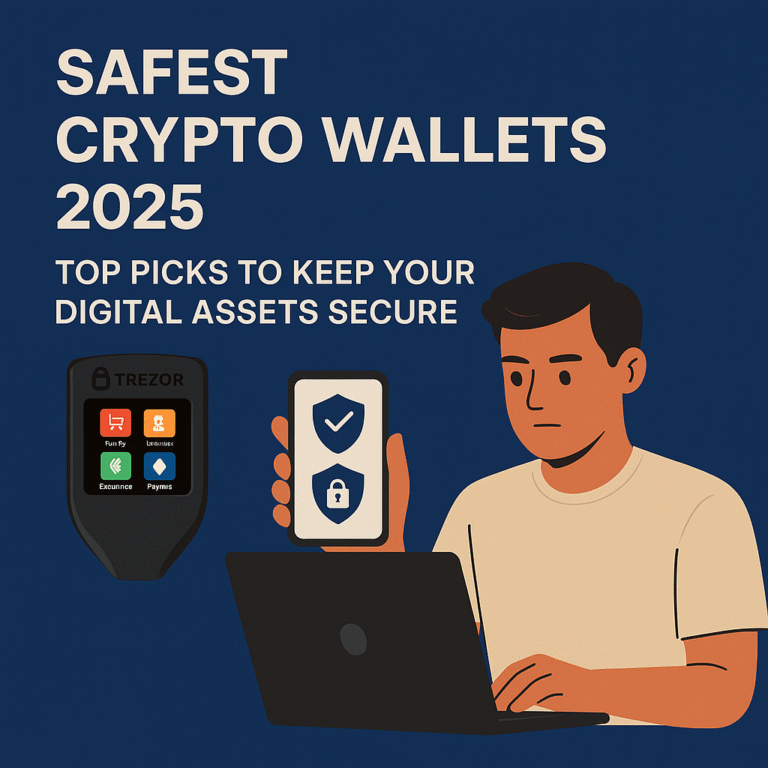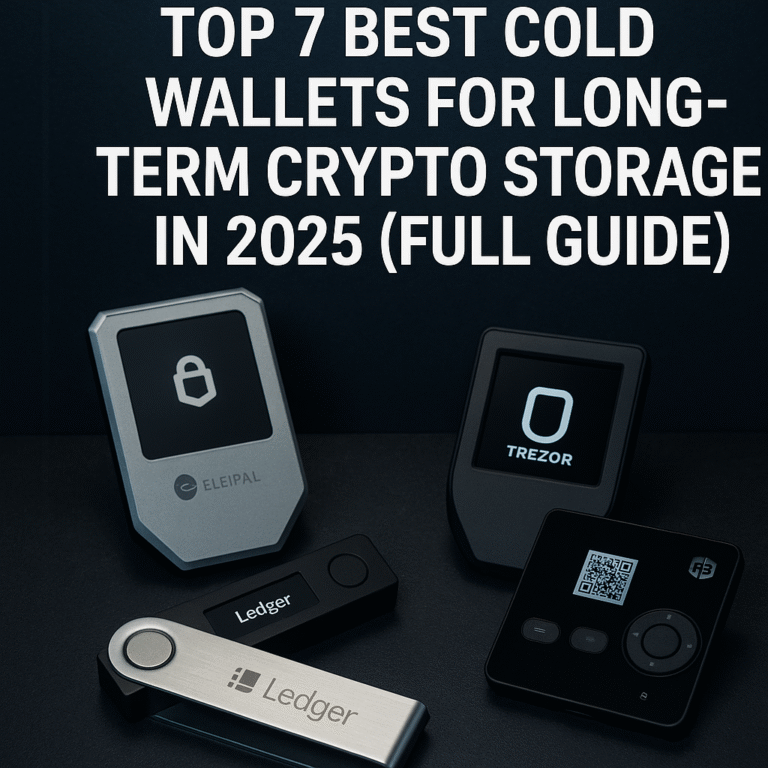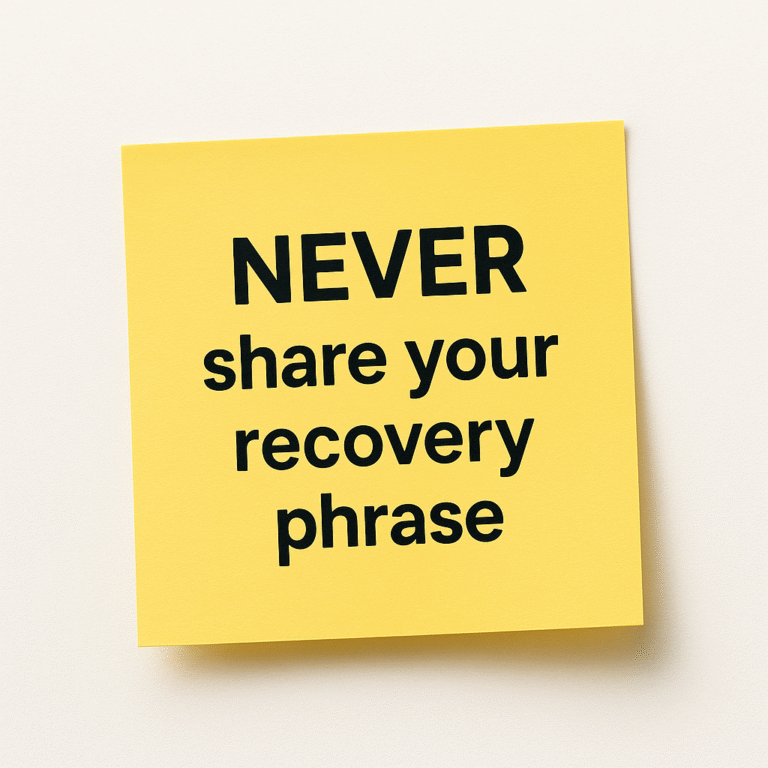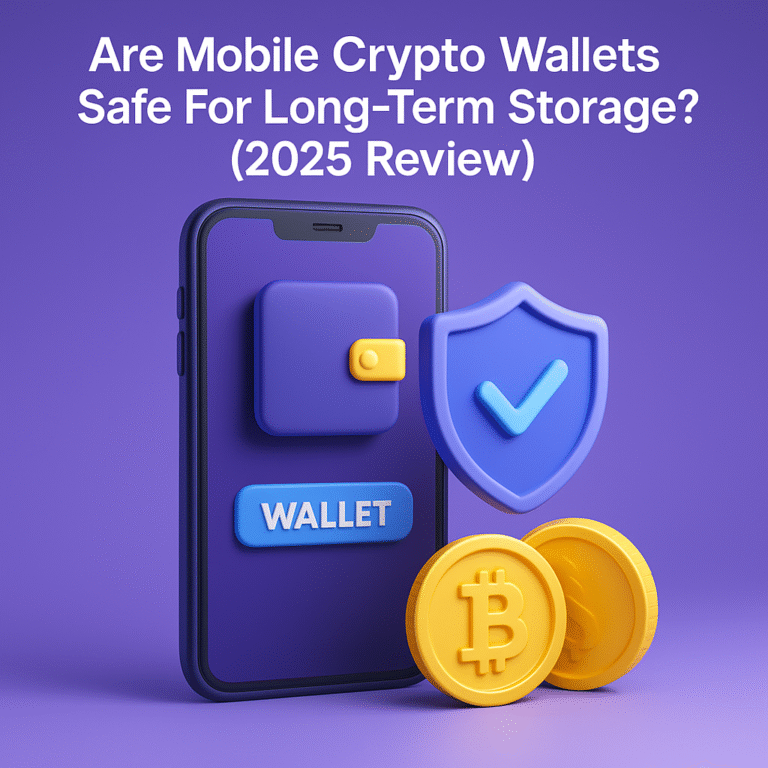Crypto Wallet Security Tips 2025 – How to Keep Hackers Out
crypto wallet security tips 2025
Discover the best crypto wallet security tips 2025 to protect your digital assets. Learn about cold wallets, 2FA, strong passwords, and avoiding phishing scams.

Many new users worry about how to keep crypto wallet safe from hackers, especially after hearing about recent cyber attacks and data leaks. Cold wallets offer better security for your digital assets than hot wallets or storing funds on cryptocurrency exchanges. 1 This guide gives you clear steps, simple tips, and real tools like two-factor authentication (2FA), hardware wallets such as Ledger Nano X, password managers, and ways to spot phishing scams. 2 Stay alert—your money depends on it! 3
Key Takeaways
- Use cold wallets for long-term storage because they’re offline and safer from hackers.
- Always enable two-factor authentication (2FA) to add an extra layer of security.
- Update wallet software regularly to protect against new threats.
- Avoid public Wi-Fi when accessing your crypto wallets as it can be risky.
- Learn to spot and avoid phishing scams and fake platforms to keep your assets safe.
Use Secure Crypto Wallets

Pick wallets that use strong encryption and support security features like two-factor authentication. Using secure holders for your digital assets lowers the chance of hacks or malware attacks—this helps keep your bitcoin, tokens, and private keys out of reach from cyber criminals.
Hot Wallets vs. Cold Wallets

For new crypto investors, understanding the differences between hot and cold wallets is key to protecting your digital assets. Review the table below for a detailed, side-by-side summary—helping you visualize the benefits and risks of each storage solution before you make your choice. 1
| Feature | Hot Wallets (Mobile, Desktop, Web, Exchange Wallets) | Cold Wallets (Hardware, Metal Wallets) |
|---|---|---|
| Connection | Online, always connected to the internet | Offline, disconnected from the internet |
| Use Case | Easy for frequent transactions or daily use | Ideal for long-term storage, rarely accessed funds |
| Popular Tools | MetaMask, Trust Wallet, Coinbase Wallet, Exodus | Ledger, Trezor, metal seed storage plates |
| Security Level | Vulnerable to hacking, malware, phishing attacks | Enhanced protection; not exposed to online threats |
| Cost | Usually free, low startup cost | $60 to $200; initial investment for hardware devices |
| Backup Method | Digital backups, often synced with cloud or device | Physical backup; paper or metal stored securely |
| Risks | Prone to hacks if device gets compromised; risk from public Wi-Fi | Physical loss or damage possible; must protect seed phrases carefully |
| Example Scenario | Managing small balances for trading or spending | Securing savings or large investments long-term |
| Who Uses Them | Active traders, users who need fast access | Long-term holders, security-focused investors |
Choosing wisely between hot and cold storage shapes your crypto security plan. Strong habits today can save you from future losses. Aim for a storage mix that matches your goals, risk level, and how often you need access.
Hardware Wallets for Maximum Security

Hardware wallets take your cryptocurrency security to the next level. These devices hold your private keys offline, keeping them safe from hackers and harmful software. Ledger Nano X supports over 5,500 cryptocurrencies and costs $149. 2 It is great for beginners wanting better control over their digital assets. Trezor Safe 3 handles more than 7,000 digital assets for just $79, and its open-source code lets experts check if it is secure. 2
If you only buy bitcoin or want extra safety, COLDCARD is a smart choice. It only stores bitcoin and offers some of the best protection out there but comes at a price of $157.94. Cold storage wallets like these generally last five to ten years before needing an upgrade as technology changes fast in this space.
Keep your crypto keys off risky places—hardware wallets act like vaults for your money.
Protect Private Keys and Seed Phrases

Your private keys and seed phrases hold the power to unlock your digital wallets—guard them like treasure. Keeping these secure shields your crypto assets from hackers, phishing scams, and data loss.
Never Store Digital Copies

Never save private keys or seed phrases as digital copies on your devices, apps, cloud storage, emails, USB drives, or Google Drive. Hackers can access screenshots and files on phones and computers using malware, phishing scams, or keystroke logging.
Fake websites may trick you into uploading sensitive data by pretending to be a reputable exchange like Bitfinex or Bitmart.
Writing down private keys and seed phrases on paper or metal plates keeps them out of hackers’ reach. Store the written backup in a fireproof and waterproof safe inside your home. 3 Digital wallets such as Ledger Nano X protect assets with blockchain technology; however, keeping digital records increases risks no matter how strong your password is or if you use two-factor authentication (2FA) with Google Authenticator. 4 Take this step for better crypto security and avoid costly loss of cryptocurrency tokens from malicious attacks online.
Use Paper Backups in Secure Locations

Write your seed phrase or private key on paper using a pen. Do not save it as a digital file, photo, screenshot, or upload to cloud storage. Digital records can be hacked by cybercriminals searching for ways to steal cryptoassets from digital wallets and hot wallets.
Paper backups remove this risk. 5
Keep the written backup in a safe location only you trust, like a locked drawer at home or a deposit box at your local bank. Avoid sharing copies with anyone else. Protecting these physical records is just as important as securing passwords for online accounts like Facebook or Google Authenticator codes used in two-factor authentication (2FA).
Secure paper backups are an extra shield against crypto scams and hackers trying to decrypt wallet access. 4
Now consider boosting safety further with two-factor authentication (2FA).
Enable Two-Factor Authentication (2FA)

Two-factor authentication (2FA) doubles your crypto wallet security. It makes sure only you can access your digital assets, even if someone knows your password. Always choose an authenticator app like Google Authenticator or Authy instead of SMS codes.
SIM-swap attacks make text messages easy targets for hackers. 6
Hardware security keys, like Ledger Stax and YubiKey, give the highest level of protection for hot wallets and mobile wallets. Security experts from the Securities Investor Protection Corporation suggest using these tools to stop unauthorized access to cryptocurrency investments.
With two-factor authentication, a hacker needs more than just your password.
Set up 2FA on all reputable exchange accounts and digital wallets that support it. This extra layer turns simple account logins into strong defenses against phishing scams and fake platforms trying to steal your private key or passcodes. 7
Use Strong and Unique Passwords

Hackers try common tricks to break into digital wallets. A strong password stops them cold. Mix upper and lower-case letters, numbers, and special symbols. Never use the same password for your crypto wallet as you do for your email or social media accounts.
Your wallet’s password should stand alone—different from any “favorite” passwords you recycle elsewhere. 8
Password managers like LastPass help create and store long, unique passwords that are hard to crack. Updating your cryptocurrency wallet’s password every few months adds another layer of defense against phishing scams and hacks.
Using a tool such as Ledger Nano X combines a hardware wallet with secure authentication options too, making unauthorized access nearly impossible even if someone guesses one of your passwords.
This step keeps your digital assets safe while giving you peace of mind about cryptocurrency investments stored in hot or mobile wallets on exchanges or apps. 5
Implement Multi-Signature (Multi-Sig) Wallets

Multi-signature (multi-sig) wallets boost crypto security by needing several people to approve a transaction. For example, instead of one person with a private key, you might use a 2-of-3 setup.
This means two out of three users must agree before any digital assets move. Groups or teams like DAOs and companies often use multi-sig wallets on platforms such as MetaMask or Ledger Nano X. 9
Choosing setups like 4-of-7 or even 8-of-9 spreads control among more signers and cuts the risk of crypto scams or theft. These steps make it hard for hackers to steal your cryptocurrency investments from hot wallets or mobile wallets, even if they get one set of credentials.
Move forward by making sure your wallet software stays current to block new threats and keep your coins safe.
Regularly Update Wallet Software

Cyber attackers find new ways to break into digital wallets every month. Wallet software makers, like Ledger and Trezor, push out security patches and updates often. Updates help fix safety holes before hackers can use them against you.
Install these software updates as soon as they come out—sometimes waiting just one week opens doors for crypto scams. 10
Missing an update can leave your crypto wallet exposed to double-spend attacks or phishing scams through fake platforms. For example, experts saw a major vulnerability patched in MetaMask in early 2024 that blocked private key thefts from Google Chrome browsers.
Staying current protects your digital assets, secures strong passwords, and keeps two-factor authentication (2FA) working right.
A wallet that’s up-to-date is a locked door to hackers.
Next up: learn how to spot suspicious activity so you always stay ahead of threats.
Monitor Wallet Activity for Suspicious Behavior

Keep a close eye on all your digital wallet activity. Use advanced monitoring tools, like Extractor, for real-time tracking and instant alerts if anything unusual happens. 11 Watch for any unknown or unauthorized transactions in your hot wallet or mobile app.
These could mean someone is trying to steal your cryptocurrency investments.
Rapid action can save you from big losses if hackers strike. Set up notifications to know right away about changes inside your wallets. Many reputable crypto wallets support these alert features today, making them easy to use even for new investors.
Regular checks help spot problems early—take every alert seriously and act fast to protect your digital assets from crypto scams and phishing schemes in 2025’s fast-changing world of cryptocurrency storage.
Avoid Storing Large Assets on Exchanges

Crypto exchanges like Coinbase or Gemini help you buy bitcoin and other digital currency. Yet, holding a large amount of digital assets on these platforms puts your money at risk. Hackers break into crypto wallets on exchanges every year, causing losses in the millions. 7 Relying only on exchange insurance is risky; their coverage has strict limits and gaps. For example, the federal deposit insurance corp does not protect cryptocurrency investments stored with an exchange, and no securities investor protection corporation (sipc) backs up those funds.
Move most of your coins to cold wallets, such as a ledger nano x or another hardware wallet. You control your private key this way—no middleman involved. 12 This step makes sure hackers can’t target all your crypto assets in one place if an exchange falls victim to scams or technical problems.
Use hot wallets just for daily transactions instead of keeping savings there long-term; it’s a smart move for top-notch security and peace of mind.
Use Reputable and Encrypted Wallet Services

Choose wallet services with a strong track record, such as Ledger Nano X or prominent digital wallets linked to reputable exchanges. Only use platforms that provide full encryption for your private keys and sensitive data. 5 Avoid unofficial apps or sites promising quick gains with crypto investments; these are often scams or phishing sites.
Always check if the service supports two-factor authentication (2FA), like Google Authenticator, for an extra layer of security. 8 The right platform will keep your cryptocurrency wallets safer from hackers, theft, and common crypto scams.
Reliable options lower the risk of losing digital assets to weak protection methods. Learn how public Wi-Fi can put your money at risk next.
Be Cautious with Public Wi-Fi Connections

Public Wi-Fi networks are often open and easy for hackers to attack. Many places like airports, cafes, and hotels provide free Wi-Fi, but these connections can be unsafe for your digital wallets. 13 Man-in-the-Middle attacks are common on public Wi-Fi. In this type of attack, a hacker sits between you and the website or app you use. The hacker can steal private keys or grab sensitive information as it passes through the network.
Session hijacking is another real threat; someone could take control of your wallet’s session without you knowing. Fake access points also trick users into joining what looks like a safe hotspot, then stealing details needed to get into hot wallets or mobile cryptocurrency investments. 13 Avoid buying bitcoin or moving assets using free public Wi-Fi whenever possible. Use a trusted VPN if safer Internet is needed in public spaces—this gives some extra crypto security by encrypting data before sending it out onto the web. 5 Secure networks protect strong passwords, Google Authenticator codes for two-factor authentication (2FA), and keep personal info safer from common crypto scams linked to bad wireless connections in 2025.
Avoid Phishing Scams and Fake Platforms

Scammers send phishing emails that look just like messages from banks, cryptocurrency exchanges, or digital wallets. They may even set up fake platforms to steal your private keys and access your crypto wallet.
In 2024, hackers used fraudulent airdrops and social engineering tactics to trick users into sharing their security details. 14
Only download hot wallet apps from verified sources such as Google Play Store or Apple App Store. Never click links in suspicious emails or on unknown websites; instead, type in the address yourself. 5 Do not share passwords, public keys, or use unknown QR codes with anyone asking online. Always check if a platform is regulated by entities like the Security and Exchange Commission (SEC) or insured by Federal Deposit Insurance Corp (FDIC).
Taking these steps can protect both small bitcoin investors and people who keep large digital assets safe from common crypto scams.
Diversify Storage Methods for Added Security

Spread your digital assets across different crypto wallets. Use hot wallets like Trust Wallet or Coinbase Wallet for daily cryptocurrency transactions and quick access. Choose cold wallets, such as Ledger Nano X or Trezor, for long-term cryptocurrency storage.
Cold wallets keep your private key offline, away from internet threats.
Switch between several storage types to reduce the risk of losing all funds during a hack or loss. Store larger amounts in hardware wallets that never touch the internet. Keep only small amounts in mobile wallet apps for spending money.
Many smart investors split their assets this way after buying bitcoin on reputable exchanges like Coinbase or Kraken. 5
Explore advanced tools next, including hardware security modules (HSMs), to level up protection even more.
Consider Advanced Tools like Hardware Security Modules (HSM)

Hardware Security Modules, also called HSMs, add strong protection for your digital assets. These devices keep your private keys stored away from the internet. Big banks and reputable exchanges rely on HSMs because they protect against online hacks.
If hackers try to break into an HSM, built-in features will destroy the data instead of letting it get stolen. This makes your crypto wallet even safer than a regular cold wallet. 15
Most new investors start with hot wallets or mobile apps, but as you buy bitcoin or other coins in larger amounts, think about advanced tools like an HSM for top-tier crypto security.
Using an HSM means your private key stays offline at all times—reducing risk from hackers and phishing scams that target digital wallets daily. Now look into ways to combine different storage methods for even more safety in storing cryptocurrency investments.
Conclusion

Protecting your digital assets starts with smart choices. Use cold wallets like Ledger Nano X for extra protection. Always keep private keys and passwords safe, never online. Add layers of security such as two-factor authentication and regular software updates.
Make these habits part of your crypto routine to help guard against hackers in 2025 and beyond.
FAQs
1. What are some ways I can keep my crypto wallet safe from hackers?
To protect your digital assets, consider using two-factor authentication (2FA) like Google Authenticator, creating strong passwords with a password manager and keeping your software updated. Also, remember to regularly check for phishing scams or Ponzi schemes that target cryptocurrency investments.
2. How do cold wallets differ from hot wallets in terms of security?
Cold wallets store your private keys offline which makes them less vulnerable to online threats compared to hot wallets. Hardware wallets such as Ledger Nano X are examples of cold storage options that provide enhanced crypto security.
3. Is it safer to buy Bitcoin or other cryptocurrencies on reputable exchanges?
Yes, buying BTC or other digital currencies on reputable cryptocurrency exchanges is generally safer because they have robust security measures in place including encryption of public keys and private key information.
4. Can the Federal Deposit Insurance Corp insure my cryptocurrency investments?
No, unfortunately the Federal Deposit Insurance Corp does not cover digital assets like cryptocurrencies stored in either hot or cold wallets.
5. What steps can I take if my inbox gets flooded with emails related to crypto scams?
Firstly, don’t click any suspicious links! Be vigilant about phishing scams where hackers may attempt to steal your private keys by pretending to be a trustworthy entity.
6. Are there specific strategies for securing cash transactions involving cryptocurrencies?
When dealing with cash transactions for cryptocurrencies ensure you’re transacting through trusted platforms only — this reduces exposure risk significantly.
References
- ^ https://www.forbes.com/sites/digital-assets/article/crypto-hot-wallets-vs-cold-wallets/ (2024-08-25)
- ^ https://coinledger.io/tools/best-cold-storage-wallets
- ^ https://www.kraken.com/learn/how-keep-crypto-safe
- ^ https://www.rockwallet.com/blog/how-to-safely-store-your-crypto-private-keys
- ^ https://www.security.org/digital-security/crypto/
- ^ https://zignaly.com/crypto-platforms/crypto-wallets/crypto-wallet-security
- ^ https://www.eccu.edu/blog/cybersecurity/cryptocurrency-cybersecurity-how-to-store-your-crypto-safely/
- ^ https://b2binpay.com/en/news/crypto-wallet-security-tips-how-to-protect-your-crypto-wallet-in-2024
- ^ https://www.cyfrin.io/blog/how-to-set-up-a-safe-multi-sig-wallet-step-by-step-guide
- ^ https://www.womentech.net/en-ro/how-to/regularly-update-your-wallet-software
- ^ https://www.extractor.live/blog/crypto-wallet-security-guide
- ^ https://www.rockwallet.com/blog/how-to-safely-store-crypto-currency—2025-cryptocurrency-guide-for-beginners (2025-01-24)
- ^ https://securitysenses.com/posts/risks-using-public-wi-fi-crypto-transactions (2025-05-13)
- ^ https://trustwallet.com/blog/security/how-to-spot-and-avoid-crypto-wallet-scams-in-2025
- ^ https://stellarcyber.ai/beyond-the-basics-advanced-techniques-for-securing-your-crypto-wallet/






